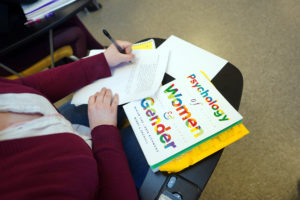Alexandra Diviney wasn’t sure what to expect when she walked into class in the University of Mary Washington’s Mercer Hall this semester. Or when she settled into her seat in Room 201 and cracked open the slick white textbook with rainbow-striped letters: Psychology of Women & Gender. Twelve weeks and a sea of lemon-colored sticky notes later, she gets it.
“That book made me look at things in a different way,” the UMW freshman said of the 600 pages she crammed full of notes, flags and tabs. “I don’t think I’ve ever read a textbook so in depth.”

That’s good news for the authors, UMW psychology professors Mindy Erchull and Miriam Liss, along with fellow psychologist Kate Richmond of Muhlenberg College. After years of struggling to teach with outdated textbooks, they set out to pen a new one. They enlisted the help of colleagues across the country, as well as Mary Washington students and alumni now challenged to teach their own similar courses. Four years later, Diviney and others in Erchull’s “Psychology of Women” course – ahead of the book’s official release in July – opened a text that brings a thriving discipline into the 21st century and puts UMW at a pivotal point in the field.
“I knew a new book needed to be on the market but I didn’t know if we’d be the ones to write it,” said Liss, who’d just completed her work-life-harmony resource, Balancing the Big Stuff, when Erchull approached her about the project. “Class discussions were getting stifled because the textbooks weren’t addressing the issues.”
Often focused on the experience of straight, white, able-bodied women, available books were published too early to cover the types of things today’s college students tackle – social media, cyberbullying, the Me Too Movement, the list goes on. Psychology of Women & Gender centers on intersectionality, the principle that a variety of factors – including age, race and religion – define each individual woman, and it encourages readers to think more inclusively.


Published by Norton, the book cites the most recent psychological research while weaving in studies from other fields – economics, political science, medicine and more. It draws attention to, rather than steers clear of, gaps in the findings, acknowledging to students that some questions don’t come with clear answers and data is often up for interpretation.
“Regardless of what you went in expecting, was there anything in the chapter that surprised you?” Erchull asked her class one recent morning. Hands flew into the air.
Real-world examples and thought-provoking features pasted throughout each section – “Your Turn,” “Think About It” “Empowering or Oppressing?” – highlight current events and get readers thinking deeply about the subjects at hand.
“They’re interesting questions that would be great to talk about in class,” said senior Shehani Peiris, one of dozens of student research assistants who helped with the textbook, hunting down articles, checking references and providing their own perspectives.

They see themselves in the pages, which cover transgender identities, non-binary individuals who don’t identify strictly as female or male, women with disabilities and other marginalized populations barely acknowledged inside older textbooks.
“I’m thrilled to see the goals we had when we started this project play out in the classroom,” said Erchull, who still had her students on the lookout for tiny typos that might have somehow squeezed through multiple rounds of previous edits.
Key terms, chapter summaries, a thorough glossary and a thick bank of support materials for instructors round out the text.
Laura Ramsey ’06, who began doing research as a Mary Washington undergrad with Erchull and Liss, is designing chapter-by-chapter PowerPoint presentations for faculty use. Now a psychology professor at Bridgewater State University, Ramsey commented on the level of thought that that went into the book, details as seemingly small as reversing the use of the commonly used phrase “men and women” to “women and men.” “It’s those little types of things that are so easy to overlook,” she said. “As soon as you switch it, you notice it, you recognize how pervasive it is.”
Ramsey has taught psychology of women since grad school but never used textbooks, preferring instead to piece together magazine articles and other more current resources. With the release of Psychology of Women and Gender this summer, she said, that will change.
“We set out to create the text we wanted to teach with and our students wanted to read,” Erchull and Liss wrote in the book’s preface. “It became so much more.”




